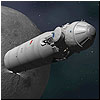


|
The L3 lunar expeditionary complex
The L3 system
was a four-element combination of rocket stages and spacecraft designed
to land a Soviet cosmonaut on the surface of the Moon, after the L3's
delivery into low-Earth orbit by the three-stage N1
rocket.
Previous chapter: 19K complex

A full-scale prototype of the L3 expeditionary complex with a mockup version of the L1-based crew vehicle during assembly in Tyuratam.
The L3 system
included:
The total
weight of the L3 system in a 290-kilometer circular Earth orbit was to
be around 70 tons. (111)
L3 flight
profile
The N1-L3
system was expected to deliver a manned spacecraft on the surface of the
Moon during a 11-12-day expedition, which included the following steps:
- The N1
rocket delivers the L3 system into the low-Earth orbit, where it can
remain up to one day;
- Block
G accelerates the L3 system to Earth-escape velocity, sending the L3
system toward the Moon;
- Block
G separates;
- Block
D completes the acceleration and conducts two trajectory corrections
during a 3.5-day flight between the Earth and the Moon;
- Block
D provides a braking maneuver, inserting the L3 system into lunar orbit,
where it can remain up to four days;
- A Block
D engine firing transfers the L3 system from a circular to an elliptical
orbit around the Moon;
- One cosmonaut
transfers from the LOK spacecraft to the LK lander, during an EVA;
- A combination
of Block D and the LK spacecraft separates from the LOK spacecraft;
- A Block
D engine firing transfers the LK lander on a descent trajectory toward
the lunar surface;
- Block
D separates from the LK lander
- Block
E engine firings onboard the LK lander provides for a soft-landing on
the Moon surface;
- A cosmonaut
conducts an EVA, during a stay on the lunar surface lasting from 6 to
24 hours;
- A Block
E engine firing provides for the liftoff of the LK ascent stage from
the lunar surface and reaching lunar orbit;
- The LOK
spacecraft docks with the LK lander;
- The cosmonaut
transfers from the LK lander to the LOK spacecraft during a spacewalk;
- Block
I onboard the LOK spacecraft provides escape velocity, sending the LOK
toward Earth;
- Block
I onboard the LOK spacecraft provides trajectory corrections during
a 3.5-day flight toward the Earth;
- A reentry
capsule of the LOK spacecraft separates from the habitation module and
the instrument section, then it reenters the Earth atmosphere and lands.
Development of the L3 complex
Basic configuration
of the L3 complex, which included the LOK spacecraft was formulated by 1963,
or roughly two years after a similar architecture of the lunar expeditionary spacecraft had been adopted in the United
States.
Before August
1964, it was already clear that the N1-L3 would not be able to support
three people during the lunar expedition, therefore the crew of the complex
was reduced to two cosmonauts with only one of them actually landing on
the lunar surface onboard the lunar module, LK,
while the second would remain in lunar orbit onboard LOK.
(78)
In December
1964, Korolev's team completed a preliminary design of the N1-L3 complex.
It envisioned the launch of a two-man spacecraft by a single N1 rocket
and the landing of one cosmonaut on the surface of the Moon. (36,52)
The expert commission led by Mstislav Keldysh evaluated the project, and
on February 10, 1965, the plan for the development of the L3 system was
officially approved. (52)
Next chapter: L3M complex (INSIDER CONTENT)
|
|